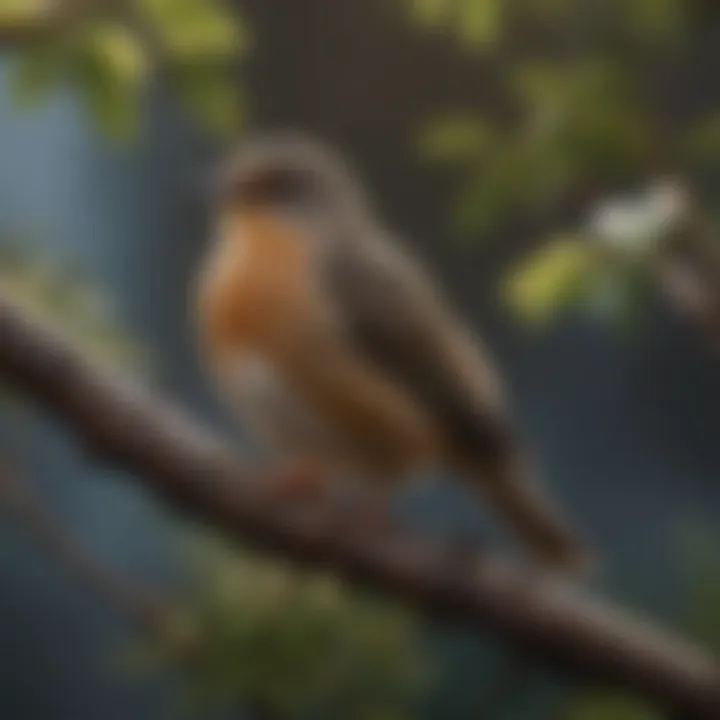Enhancing Bird Cages with Natural Branches: A Guide


Intro
Incorporating branches into bird cages is essential for enhancing the environment for pet birds. This article delves into why branches are crucial for avian health and well-being, the different types available, how to source them, maintain a safe space, and improve overall bird behavior. The aim is to equip pet owners with practical advice and understanding, ensuring a holistic approach to bird care that could significantly enrich their pets' lives.
Understanding Your Pet
Pet Behavior Basics
Birds are complex creatures with needs that vary greatly across species. Understanding their behavior is paramount. Birds often exhibit natural instincts like climbing and chewing. Thus, incorporating branches can mimic their natural habitat, leading to healthier and happier pets. The ability to perch and explore allows birds to engage in enjoyable activities, which can have a positive impact on their mental well-being.
Common Breed Characteristics
Each bird species has its unique traits that affect how they interact with their environment. For instance, parrots tend to be more social and enjoy climbing, while canaries may prefer ground activities. Knowing these characteristics helps in selecting the proper branches that will satisfy specific needs. Understanding these traits enriches the owner's experience, making the bond stronger.
Species-Specific Needs
Different species require different types of branches. For example, larger birds like macaws benefit from thicker, sturdier branches, whereas smaller birds like budgerigars thrive with lighter, flexible options. It’s important to tailor the branch types to the species, ensuring safety and enhancing their natural behavior. Researching species-specific needs can aid in sourcing the right branches that cater to perceptive differences.
Pet Care and Maintenance
Feeding Guidelines
A balanced diet contributes greatly to a bird’s overall health. When providing branches, it is essential to consider any edible options, like willow or herbal branches. These can complement their diet while offering physical activity. Understanding quality nutrition is vital to keep birds healthy and active.
Grooming Essentials
Regular grooming is necessary for maintaining a bird's health. Branches can assist in natural beak wear, reducing the need for frequent trims. Providing varied textures and sizes helps in keeping a bird's nails and beak in check. Owners should monitor their birds to ensure they are utilizing the branches effectively.
Hygiene Practices
Maintaining hygiene is crucial for the health of birds. Branches should be cleaned regularly to prevent the accumulation of dirt and droppings. Always inspect branches for mold or decomposition, which may harm your pet. This practice promotes a fresh and safe environment, ultimately supporting bird health.
Training and Development
Basic Commands and Skills
Incorporating branches in training settings can aid significantly in avian learning. Birds can be trained to move from branch to branch by rewarding them with treats. This encourages physical movement and mental engagement, both necessary for development.
Behavioral Training Techniques
Using branches in behavioral training allows owners to create an enriching environment. Techniques such as teaching birds to explore easily encourages positive behavior. Birds trained in engagement tend to be more relaxed and less prone to stress-related behaviors.
Addressing Common Behavior Issues
A lack of stimulation can lead to undesirable behaviors, such as excessive squawking or chewing. By providing branches, owners can mitigate these problems. A thoughtfully arranged habitat encourages exploration and reduces boredom, essential for a bird's emotional well-being.
Health and Wellness
Routine Vet Check-ups
Regular veterinary visits are non-negotiable in bird care. Having a vet that specializes in avian health helps in early detection of issues. Along with undertaking check-ups, discussing the impact of branches on bird health can lead to better informed care strategies for pet owners.
Vaccination Needs
Understanding vaccination necessities is crucial for preventing diseases. Consult a vet on the necessary vaccinations. Combining practical care with environmental enrichment can ensure the health of the bird in an optimized manner.
Recognizing Signs of Illness
Birds can be good at hiding illnesses. Owners should be observant of changes in behavior or appearance. Loss of appetite or changes in droppings are common indicators. An environment enriched with branches allows for added interaction and ease in identifying health concerns quickly.
Enrichment and Activities
Indoor vs.
Outdoor Activities
Balancing indoor and outdoor options maximizes opportunities for exercise and exploration. Branches can be easily integrated into both settings, providing stimulation that is versatile. This encourages birds to exercise their natural instincts.
Interactive Toys and Games
In addition to branches, interactive toys are beneficial for mental stimulation. Rotating toys periodically keeps the environment novel. Birds benefit from a combination of stationary and moving elements that wdging into their daily routines as they explore branches at the same time.
Socialization Opportunities
Birds are social animals and benefit from interaction. Offering branches where multiple birds can perch encourages social behaviors. This enhances their overall happiness and decreases stress levels. Properly designed evironments are integral for fostering companionship among birds.
By consciously providing your bird with branches, you not only enrich their habitat but also promote their overall health and happiness. Selecting the right type of branch is a step towards a more fulfilled life for your pet.
Understanding the Importance of Branches in Bird Cages


Branches play a crucial role in enhancing the habitat of pet birds. This guide delves into why incorporating branches is essential for avian health and behavior. Branches not only serve as a perching option but also mimic a bird's natural environment, allowing them to express instincts and behaviors that are vital for their well-being.
Why Branches Matter for Avian Health
The significance of branches in a bird cage cannot be overstated. First, branches provide opportunities for physical exercise. Birds need to hop, climb, and maintain muscle tone. Without such physical activities, they can develop health issues such as obesity or stress-related illnesses. Therefore, some secure branches should be included to support their physical needs.
Moreover, branches contribute to mental stimulation. Birds are inherently curious creatures. When they encounter a varied environment with different textures and heights, they engage more actively. For instance, a larger branch might encourage exploration, while a thinner one may stimulate foraging behavior.
Additionally, having branches can also help in keeping their nails and beaks naturally trimmed through regular activity. Overall, incorporating branches not only promotes physical health but also contributes to the mental well-being of birds.
Role of Branches in Natural Behavior
In the wild, birds interact with a variety of surfaces, from solid tree trunks to fragile twigs. In a cage, replicating this environment with natural materials helps fulfill essential behavioral needs.
Branches provide vital opportunities for social engagement. Birds often perch close together, and meaningful interactions occur there. When multiple birds can sit on different branches, it fosters a sense of community and social bonding.
Furthermore, branches can facilitate complex movement patterns unique to various bird species. They encourage birds to climb, explore, and engage in play. This is essential for their emotional health. Failure to offer such opportunities may result in boredom and stress, leading to unwanted behaviors like feather plucking.
Types of Branches Suitable for Bird Cages
Understanding the types of branches suitable for bird cages is fundamental for enhancing your avian companions’ living spaces. This section will delve into the benefits of selecting appropriate branches, offering insights into both natural and synthetic options as well as common tree species that are safe and beneficial for birds. Selecting the right branches can impact your birds’ health, welfare, and overall happiness.
Natural Branches vs.
Synthetic Options
When deciding between natural branches and synthetic options, several factors must be taken into consideration.
Natural branches can provide various textures and sizes, which often mimic a bird's natural habitat. They offer perching spaces that promote physical exercise. The irregular surfaces encourage claw engagement, which is essential for maintaining healthy feet. Some natural branches also have nutritional benefits, as they can contain essential oils and nutrients that birds can ingest.
However, it is crucial to ensure that these branches are free from pesticides, chemicals, or notable mold. Proper cleaning and sanitizing methods are essential steps in preparing natural branches for use.
On the other hand, synthetic options can offer uniformity and ease of cleaning. They are often made from materials that are resistant to wear, ensuring a long-lasting usage. While they lack the health advantages that natural branches might provide, synthetic options can be designed with features that mimic the look and feel of natural wood, making them visually appealing. Make sure, however, to select safe materials that do not contain harmful substances like BPA or phthalates.
In summary, both natural and synthetic branches have their place in a bird cage. Knowing when to use which type largely depends on your bird's species, needs, and specific behaviors you wish to promote.
Common Tree Species Used for Branches
Selecting the right tree species is crucial as certain woods can be toxic to birds. Below are some common tree species that are generally safe and advantageous for use in bird cages:
- Apple: Provides a sturdy, durable perch. Can have a light, sweet aroma that many birds enjoy.
- Willow: Offers good variety in texture and flexibility. It's often a favorite for birds to chew on.
- Pine: Softwood that is also easy to find. This wood can be a delightful item that encourages chewing. Consider avoiding the resinous type.
- Maple: A hard wood that provides strength for perching. It's less likely to splinter than weaker woods.
- Birch: This wood can be quite appealing due to its smooth texture and clean appearance.
Some species, like cherry and oak, can be beneficial, but always consult a knowledgeable source before introducing any branches. Birds can be sensitive to specific plants, so understanding their needs is critical for their health.
Sourcing Safe Branches for Your Birds
When it comes to enriching the living environment for birds, sourcing safe branches is crucial. These natural elements not only provide perching spots but also contribute to your bird's physical and mental well-being. Proper sourcing ensures that the branches you use are free from toxins and diseases. It's essential to understand how to identify, collect, or purchase safe branches so that your feathered friends thrive.
Collecting Branches from the Wild
Collecting branches from the wild can be a rewarding and enjoyable activity. However, there are important factors to consider. First, make sure you are in a legal area where gathering branches is permitted. Always follow local regulations to avoid penalties. When selecting branches, ensure they are from non-toxic tree species. Some safe options include apple, oak, and maple.
After you've found a suitable branch, check for signs of disease or pests. Avoid branches showing any discoloration, mold, or insect infestation. It is also wise to select branches that have fallen naturally rather than those that may have been cut or damaged. Before bringing the branch home, rinse it in clean water to remove dirt and debris.
Buying Branches: What to Look For
Purchasing branches can save you time and ensure safety. Here are key details to consider when selecting branches for your birds:
- Material: Look for natural, untreated wood. Avoid any branches that have been chemically treated or artificially colored.
- Size: Pick branches that are appropriately sized for your bird species. Larger birds may need thicker, sturdier branches, while smaller birds might be fine with thinner options.
- Species: Research the tree species to ensure they are safe for your birds. Some common safe options include birch and willow.
- Condition: Inspect the branches for any signs of damage or decay. They should be free of cracks and softness.
Reminder: Always confirm that any commercially bought branches are labeled as bird-safe. This is essential to protect your pets from potential harm.
By being mindful during the collection or purchase process, you can ensure that your birds have a safe and stimulating environment. Safe branches are integral to your birds’ cage, promoting not just health, but joyful, interactive behavior.
Preparing Branches for Use in Bird Cages
Preparing branches for use in bird cages is essential for ensuring the health and safety of your pet birds. Proper preparation can help prevent potential health risks associated with dirty or untreated branches. The process involves thorough cleaning, sanitizing, and treatment for any pests or diseases. By dedicating time to prepare these branches, owners can create a safer and more stimulating environment for their feathered companions.
Cleaning and Sanitizing Branches
Before introducing any branch into a bird cage, it is crucial to clean and sanitize it adequately. This step helps remove dirt, debris, and potential pathogens that could harm your birds. The task may seem simple, but it plays a significant role in maintaining a healthy living space.
Steps for Cleaning Branches:
- Initial Rinse: Start by rinsing the branch under warm water to remove any loose dirt or particles.
- Scrubbing: Use a soft-bristled brush or sponge to scrub the surface. This helps to dislodge stubborn dirt.
- Cleaning Solution: Create a solution using a mild dish soap diluted in water. Dip the brush in the solution and scrub the branch thoroughly.
- Rinsing Again: Rinse the branch with clean water to remove any soap residue.
- Sanitizing: Mix a solution of one part white vinegar to three parts water. Soak the branch in this mixture for about 10-15 minutes, as vinegar is a natural disinfectant.
- Final Rinse: Rinse again with water and let the branch dry completely before placing it in the cage.
Maintaining clean branches not only preserves aesthetic appeal but also ensures that birds aren’t exposed to harmful contaminants.
Treating Branches for Pests and Diseases


In addition to cleanliness, treating branches for pests and diseases is crucial. Pests such as mites or insects can hide in the crevices of branches. Moreover, certain types of fungi or bacteria may thrive on untreated wood. Taking preventive measures can protect your birds from these hidden threats.
Treatment Methods:
- Inspection: Examine the branch closely for signs of insects or fungal growth. Look for holes, tiny webs, or discoloration.
- Heat Treatment: One effective way to eliminate pests is by using heat. Place the branch inside a plastic bag and expose it to sunlight for several hours. The heat will help kill any hidden insects.
- Freezing: Alternatively, if feasible, freeze the branch for several days. Cold temperatures can also eliminate pests.
- Natural Insecticides: If you wish to use insecticides, opt for those designed for birds. Avoid harsh chemicals, as they can be toxic.
Once treated, branches should be monitored regularly for signs of reinfestation. This attention to detail can significantly enhance the overall well-being of your birds and create a safe haven for them to thrive.
“A properly prepared environment can make a significant difference in the happiness and health of pet birds.”
Caring for branches before use in bird cages establishes a foundation for a healthy habitat. Owners should make the effort to clean, sanitize, and monitor them regularly. Providing clean and safe branches not only benefits the birds physically but also positively influences their overall mental health and quality of life.
Designing the Cage with Branches
Designing a bird cage with branches is an important aspect of creating a suitable and enriching environment for your avian companions. Birds, by their nature, are climbers and explorers. Including branches in their living space can provide them with opportunities to express these instinctive behaviors, which are vital for their well-being. Each choice made in the design process can greatly impact their physical health and mental stimulation.
Strategic Placement and Height Considerations
When placing branches in a bird cage, one must consider both strategic placement and the height of each branch. The layout of branches should mimic the natural habitat of birds, which are often found in trees or dense foliage. Here are some key points to consider:
- Diversity of Heights: Different birds prefer different heights for perching. Offering branches at various levels allows birds to choose where they feel most comfortable. Some species, like canaries, enjoy higher perches, while others may prefer lower options.
- Spacing: Avoid overcrowding branches. Birds need space to move freely. The recommended distance between branches should allow birds to stretch their wings fully without hitting another branch.
- Accessibility: Ensure that all branches are easily accessible. Birds should not have to struggle to reach their perches. If they have to work too hard to climb, it can lead to stress or injuries.
- Visibility: Keep in mind that birds are more comfortable when they can see their surroundings. Avoid placing branches where they block the bird’s view of activity beyond the cage. This can help reduce stress and promote a sense of security.
By thoughtfully arranging branches, you can create engaging spaces that encourage natural behavior while promoting avian health.
Creating Climbing and Perching Opportunities
The inclusion of branches not only provides perching spots but also encourages climbing. Here’s how to maximize these benefits:
- Thicker Branches for Perching: Choose branches with varying diameters. Thicker branches allow larger birds to perch comfortably, while thinner ones can be suitable for smaller species. This variety can enhance perching comfort and foot health.
- Branch Angles: Position branches at different angles to create climbing pathways. Birds often enjoy moving up and down in their habitat. Inclined branches can stimulate climbing activities.
- Attach Accessories: Consider adding toys or feeders onto some branches. This further engages the birds and encourages exploration. Use safe materials to ensure that no harm comes to your birds from these additions.
- Changing Layouts: Regularly changing the arrangement of branches can also provide new challenges for the birds. This keeps their environment stimulating and reduces feelings of monotony.
Paying close attention to how branches are designed within a bird cage makes a significant difference in the overall well-being of your birds. Having a functional and inviting environment encourages exploration and promotes a healthier lifestyle.
Maintaining Branches in Bird Cages
Maintaining branches within bird cages is essential for both the safety of the birds and the longevity of the branches themselves. Proper maintenance ensures that the environment remains healthy and stimulating for avian residents. Branches can harbor bacteria or pests if not properly cared for, so establishing a routine is key. Not only does maintenance keep the branches clean, but it also prevents potential health issues related to contamination or injury. Thus, pet owners must prioritize a maintenance regimen to enhance their birds’ quality of life.
Regular Cleaning Routines
A regular cleaning routine is vital in preserving the health of branches in bird cages. Cleaning branches reduces the buildup of dirt, food particles, and feces, which could lead to fungal growth or bacteria.
Here are essential steps to establish an effective cleaning routine:
- Frequency: Clean branches at least once a week, ensuring to monitor any spots that may require more frequent attention.
- Tools: Use a soft brush, warm water, and a pet-safe disinfectant. Avoid harsh chemicals that can harm birds.
- Method: First, remove the branches from the cage. Brush gently to remove any dirt. Soak them in the warm water solution for a few minutes and then rinse thoroughly. Allow them to dry in the sunlight, as UV rays can help eliminate remaining germs.
Implementing these steps can help maintain hygiene and ensure a healthier living space for birds.
Inspection for Wear and Tear
Inspecting branches for wear and tear is another crucial aspect of maintenance. Regular checks can prevent injuries that might occur if branches degrade and break. It’s also important to note that some branches might retain hidden pests that could impact your birds’ health.
To effectively inspect branches, consider the following:
- Visual Inspection: Look for signs of splinters, cracks, or chewing marks which may indicate that a branch is weakening.
- Texture Check: Run your hands along the surface of branches to feel for rough patches or softness that may indicate rot.
- Replace if Necessary: If a branch appears damaged or unsafe, it should be removed promptly. Always have suitable replacement options handy, considering factors such as size, species, and overall health safety.
The health of your birds largely depends on attention to the details of their habitat, including branch upkeep. Regular checks and cleaning can significantly enhance their living experience.
By adopting these practices, pet owners contribute to a safer and more comfortable environment for their birds, enhancing their overall well-being.
Recognizing Health Benefits for Birds
Understanding the health benefits that branches provide to birds is crucial for bird owners. These benefits go beyond mere aesthetics and contribute significantly to the physical, mental, and emotional well-being of pet birds. Incorporating branches into bird cages serves to mimic a more natural habitat, which is essential for avian health. It enriches their living environment, facilitating behaviors that are vital for their overall happiness and longevity.
Physical Exercise and Mental Stimulation
Physical activity is essential for all birds. Branches in a cage create opportunities for climbing, perching, and exercising. When birds navigate through these natural obstacles, they promote muscle development and better coordination. This movement is not just playful; it's essential for preventing obesity, which is a growing concern in captive birds.
Birds need to stay active to maintain their weight and health. Here are several benefits of physical exercise through branch interaction:
- Strengthening Muscles: Climbing and hopping along branches develops core strength as well as muscle tone.
- Improving Coordination: Balancing on uneven surfaces aids in improving a bird’s coordination and agility.
- Encouraging Exploration: Different branch heights encourage birds to explore their cage more, simulating their natural instinct to fly and investigate their environment.
Mental stimulation is equally important for birds. A cage with branches allows birds to engage in problem-solving. They can learn to navigate their space and develop their cognitive skills. As their brain engages with the environment, they become more confident and capable, reducing the risk of behavioral problems linked to boredom.
Reduction of Stress and Boredom
Stress is a common issue for captive birds, often leading to feather plucking and other destructive behaviors. Branches play a crucial role in creating a more engaging environment that can significantly reduce stress levels.
Boredom can quickly set in if the bird's surroundings lack variety and stimulation. Here’s how branches help to mitigate these issues:
- Providing Shelter and Refuge: Branches can form hideaways, allowing birds to feel secure when they need solitude.
- Creating Social Spaces: In multi-bird households, branches provide a common ground for social interaction, helping birds develop their social skills and reducing conflict.
- Encouraging Natural Behaviors: When birds can perch, climb, and interact with their environment, they are less likely to exhibit signs of stress or aggression. This is because they can express their natural instincts, which helps to calm their minds.


“A well-structured environment encourages birds to thrive, reducing stress and enhancing their quality of life.”
In summary, recognizing the health benefits of branches is vital for anyone committed to avian well-being. From physical exercise to mental enrichment and stress reduction, the right branches can enhance the quality of life for pet birds, making their home a healthier and happier place.
Potential Risks of Using Branches
The use of branches in bird cages is not without its challenges. While branches provide numerous benefits for birds, such as enrichment and physical exercise, it is vital to recognize the potential risks involved. These risks can affect both the health of the bird and the overall safety of the cage environment. Understanding these considerations can help pet owners make informed decisions about the branches they select for their feathered companions.
Identification of Toxic Wood Types
One of the most critical aspects of using branches in bird cages is the identification of toxic wood types. Some wood species contain harmful substances that can adversely impact a bird’s health if ingested or chewed on. For instance, cedar and pine are often cited as potentially harmful wood types. Pine contains phenols that can irritate a bird’s respiratory system, while cedar can lead to liver toxicity. Similarly, the wood from yew and oleander are highly toxic and should always be avoided.
To ensure the safety of your bird, it is essential to research and confirm which wood species are safe. Keeping toxic woods out of your bird's environment can prevent serious health issues. Always consult reputable sources, like the ASPCA or avian veterinarians, for accurate information on safe and unsafe woods.
Preventing Injuries from Branches
While branches can enhance a bird's habitat, they can also pose physical risks if not properly managed. Sharp edges on branches or rough surfaces can cause cuts or injuries to a bird’s feet or skin. Therefore, it is crucial to inspect branches regularly for any signs of wear and tear.
Here are several strategies for preventing injuries:
- Select Appropriate Branches: Choose branches that are thick and sturdy enough to support the bird's weight without breaking under pressure.
- Smooth Rough Edges: Sand down any jagged or sharp edges to minimize risk. This ensures a safe perching space for your bird.
- Regular Inspections: Conduct routine checks for wear and tear, replacing any branches that show significant signs of damage.
By taking proactive measures regarding branch safety, you enhance your feathered friend’s living environment, reducing the risk of injuries and promoting overall well-being.
Social Dynamics and Branch Interaction
Understanding how branches influence the social dynamics of birds in cages is essential for creating a suitable environment. Birds are inherently social creatures, and their interactions can be greatly affected by their surroundings. Branches serve as more than just perches; they establish physical structures that facilitate and influence interaction among birds. This section explores the link between branch placement and social behavior, as well as how branches can act as tools for bonding among birds.
How Branches Influence Social Behavior
Branches create physical spaces that birds use for various activities. These activities can include preening, foraging, and socializing. When birds have access to different heights and types of branches, they can establish hierarchy and territory. In a cage with limited space, social tension can increase. Conversely, a diverse branch setup encourages movement and helps disperse potential conflicts.
Branches also impact visibility among birds. This visibility can either promote social interaction or provide retreat opportunities when needed. For example:
- Visibility: Branches that are well-placed allow birds to observe each other. Birds feel safer when they can see their companions while engaging in playful behaviors.
- Security: Higher branches act as safe zones where less dominant birds can avoid confrontations. This arrangement allows for a more peaceful cohabitation.
When multiple birds share a branch, there might be displays of dominance or bonding behavior. Observations show that even simple social dynamics play a critical role in a bird’s happiness. A stimulating environment with varied branches is crucial in supporting these social structures.
Facilitating Bonding Through Branch Use
Branches can enhance bonding among birds by providing opportunities for shared experiences. When birds engage in activities together, it strengthens their social connections. Activities that occur on or around branches can include:
- Preening: Birds often preen each other while perched together, which is a sign of trust.
- Foraging: If branches have natural textures, birds can engage in foraging behavior, promoting teamwork as they search for food.
- Play: Interactive play on branches encourages social bonds and helps reduce stress.
Moreover, offering a variety of branches with different diameters can cater to the preferences of different species. Some birds prefer wider branches for stability, while others lean towards thinner branches for agility. This diversity allows for more comfortable interactions.
Innovative Ideas for Branch Utilization
Incorporating innovative ideas for branch utilization can significantly enhance the living environment for birds in captivity. By creatively using branches, you can improve both the physical and mental well-being of your avian companions. This not only mimics their natural habitat but also encourages natural behaviors that are crucial for their health.
Creating Multi-Layered Perches
Multi-layered perches provide various heights and surfaces for birds to explore and occupy. This arrangement mimics the complexity of a natural habitat, promoting physical exercise and stimulating curiosity. Here are some key benefits of multi-layered perches:
- Encouragement of Exercise: Birds love to climb and hop from one level to another. Multi-layered perches encourage them to engage in physical activities, helping to maintain their fitness.
- Social Spaces: In a social setting, different birds may prefer different heights. Providing multiple levels allows for individual preferences and reduces territorial conflicts.
- Variety in Texture: Different branches offer different textures. Mixing smooth and rough surfaces can promote healthy feet and prevent foot problems.
When designing multi-layered perches, consider using branches from various tree species. This variation adds interest and encourages birds to explore their space.
Incorporating Enrichment Tools with Branches
Enrichment tools can be integrated with branches to provide additional mental stimulation for birds. These tools make a bird's environment more engaging and can include items such as:
- Toys: Attaching toys to branches allows birds to play and interact in their enclosures. This can be a source of amusement and helps prevent boredom.
- Foraging Elements: Hiding food or treats within the branches encourages birds to search and forage, promoting natural behaviors.
- Natural Elements: Elements like leaves or twigs encourage exploration and can satisfy some of the bird's instinctual behaviors.
When incorporating these tools, ensure everything used is safe and non-toxic for birds. This enhances their ability to exercise both physically and mentally, leading to a healthier and happier pet.
"Innovative ideas for branch utilization can turn a basic cage into an enriching environment, fostering both physical activity and mental engagement among birds."
By focusing on creative branch utilization, pet owners can adopt a more holistic approach to avian care, transforming cages into thriving habitats that cater to the diverse needs of their feathered companions.
End: Enhancing the Living Space for Birds
The inclusion of branches in bird cages plays a crucial role in enhancing the living environment for birds. A well-constructed habitat not only promotes physical health but also supports mental well-being. Natural branches provide texture and varying heights, enticing birds to explore and exercise. The stimulation from these interactive features is vital for their overall happiness and health.
When selecting branches, it is important to consider the type of wood, ensuring it is free from toxins and safe for avian use. Sourcing branches that mimic their natural habitat can lead to better behaviors, reducing stress and boredom. Moreover, regular maintenance and cleaning of branches are essential to keep the cage environment healthy.
Beyond mere aesthetics, branches facilitate social interactions among birds. Their natural positioning encourages socializing and bonding, enriching their experiences. It is prudent to monitor how your birds utilize the branches, as this insight can inform future designs and arrangements.
Final Thoughts on Branch Use
In summary, integrating branches into bird cages is more than a decorative choice. It is an essential element that significantly enhances the quality of life for birds. Pet owners should recognize the necessity of creating an environment where birds can climb, perch, and engage with their surroundings.
By considering the safety, sourcing, and maintenance of branches, owners can provide a thriving habitat. This investment in their well-being is invaluable, benefiting both the birds and their caregivers through enhanced companionship and enjoyment.
“An enriched, thoughtful living space not only keeps birds healthy but also fosters a profound bond between pet and owner.”
Embracing the importance of branch use will inevitably lead to better outcomes for avian health and happiness.







